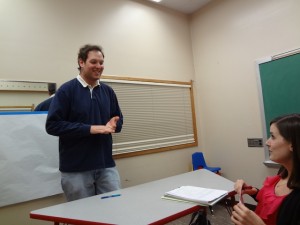
The Adult Voice and Fluency Clinic offers activities that apply to clients' daily lives (Communicative Disorders and Sciences photo).
By Amanda Holst, Public Affairs Assistant
For some, the fear of giving a class presentation or interviewing for a job can be overwhelming, especially for those who stutter.
The Department of Communicative Disorders and Sciences has added an Adult Voice and Fluency Clinic to its list of specialty clinics, providing clients, including SJSU students, the opportunity to work together to improve their communication skills.
“A lot of times, people who stutter want to hide it,” Assistant Professor Pei-Tzu Tsai said. “In therapy, we aren’t only addressing the stuttering part, but also the feelings and attitudes that come with it.”
The clinic, within the Kay Armstead Center for Communicative Disorders, helps clients minimize their fear of talking and stuttering, becoming more effective communicators.
“They work on their speech techniques to help them move through the moments when they get stuck,” Tsai said. “They also talk to each other about their feelings and attitudes which helps them to open up.”
Clients apply through the Kay Armstead Center, and then are evaluated by student clinicians, who admit them to a weekly group therapy program based on their individual needs.
Student Clinicians
“As a student clinician, I have the opportunity to apply what I learn in class to different clients,” said communicative disorders graduate student Chenjie Gu. “My favorite part is helping clients develop better communication skills.”
Nick Puzar is one of five students taking part in the program.
“The clinic has helped me understand what stuttering is, what parts of stuttering can be treated, how different types of treatment work, and what resources are available to myself and others in the clinic,” Puzar said.
Tsai hopes to expand the clinic to serve children and teenagers and wants to gradually implement clinical research that will test therapy and improve efficacy.

